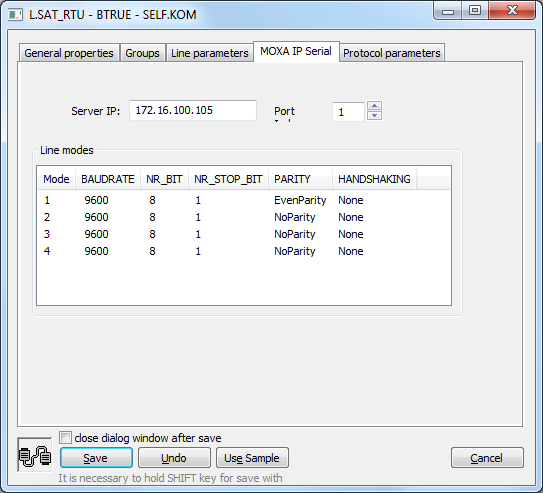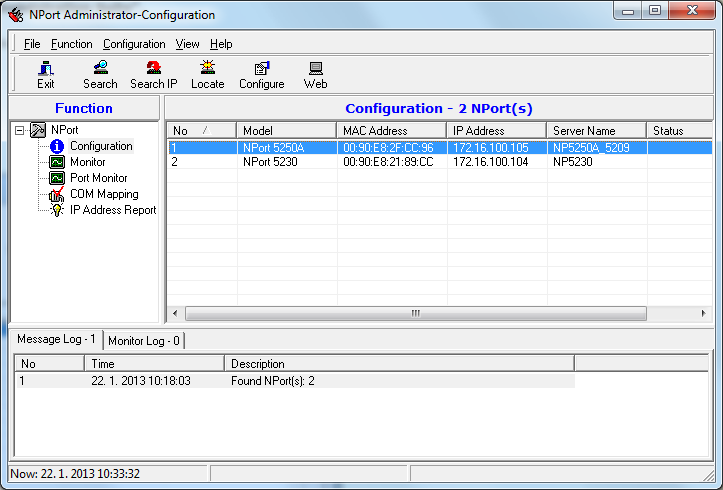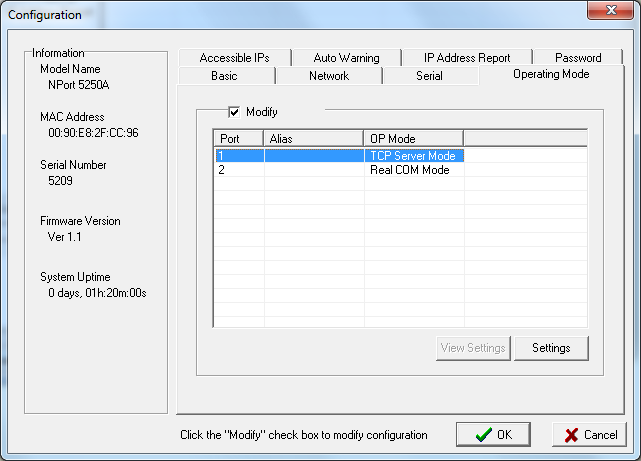Communication line of "MOXA IP Serial Library" category
The "MOXA IP Serial Library" communication line supports the communication with the converters of serial interfaces (device servers), NPort series. Unlike the "SerialOverUDP Device Redundant" and "SerialOverUDP Line Redundant" lines, the transmission parameters may be set remotely, i.e. from the configuration of a line in the D2000 System.
The line of this category can be used only on the Windows platform.
The IPSerial library must be installed on the computer, where the KOM process with the "MOXA IP Serial Library" line will be running. It is a part of the "NPort Administration Suite" pack, which can be downloaded from the site www.moxa.com.
Parameters
Configuration parameters of the "MOXA IP Serial Library" line.
Server IP
IP address (recommended) or DNS name of Moxa NPort Device Server.
Port Index
Port index of NPort Device Server. The index of the first port is 1.
Line modes
Transmission parameters can be set for four modes, as when setting the "Serial" and "Serial Line Redundant" lines.
Configuration of NPort Device Server
The configuration of the Moxa NPort Device Server can be done using the "NPort Administration Suite" software or through the common internet browser, if the configuration of the NPort Device Server via the web is enabled.
Configuration by "NPort Administration Suite".
After searching a device, in the list double-click on the particular NPort Device Server to start its configuration (Fig. 2).
Fig. 2 Selecting of NPort devices
The ports are configured in the Operating Mode tab (Fig. 3).
Fig. 3 Configuration of device ports
To modify the parameters, check "Modify". Double-clicking on the port opens the Operating mode dialog window. It is intended for the configuration of the operating mode of a particular port (Fig. 4).
Fig. 4 Default configuration of Port 1 using the "NPort Administration Suite".
Operating Mode must be set to "TCP Server Mode". Pay attention to the setting of TCP ports - "Local TCP Port" and "Command Port" mainly if D2000 and NPort Device Server are connected via router/firewall. See the next paragraph "TCP and UDP ports".
TCP and UDP ports
The communication between the IPSerial library and NPort device uses several TCP and UDP ports. TCP channel "Local TCP Port" is used for data transmission, where the device receives data to send them to the serial port and vice-versa where it sends the received serial data of connected client IPSerial (so-called data channel). Another TCP channel is the "Command Port" control channel.
The values of "Local TCP Port" and "Command Port" have the default values (see the tables below), but they can be changed. UDP channel is the third communication channel between IPSerial library and NPort device, through which IPSerial gets the accurate values of "Local TCP Port" and "Command Port". For NPort 5000 Series it is 4800/UDP and for NPort DE-311/211/30x/33x it is 1029/UDP. This port cannot be changed. It is an input point to the device. Data must always be routed to this port and non-blocked by a firewall.
Preferred well-known ports
Source: FAQ on the site www.moxa.com.
[For NPort 5000 Series; NPort W2x50, NE-4100 and MiiNePort Series] – Device Servers
Protocol | Port No. | Purpose |
|---|---|---|
| TCP | 23 | Telnet |
| TCP | 80 | Web Console |
| TCP | 950(~965) | Data Port (actually used 4001~4015) |
| TCP | 966(~981 ) | Command Port |
| UDP | 4800 | Broadcast, Monitor, Get current settings, RealCOM Port mapping |
| TCP | 4900 | Write Firmware |
[For DE-311/211/30x/33x] – Device Servers
| Protocol | Port No. | Purpose |
|---|---|---|
| TCP | 23 | Telnet |
| TCP | 4000 | Write Firmware |
| TCP | 950(~965) | Data Port |
| TCP | 966(~981) | Command Port |
| UDP | 1029 | Broadcast, Monitor, Get current settings, RealCOM Port mapping |
Related pages:




Pridať komentár